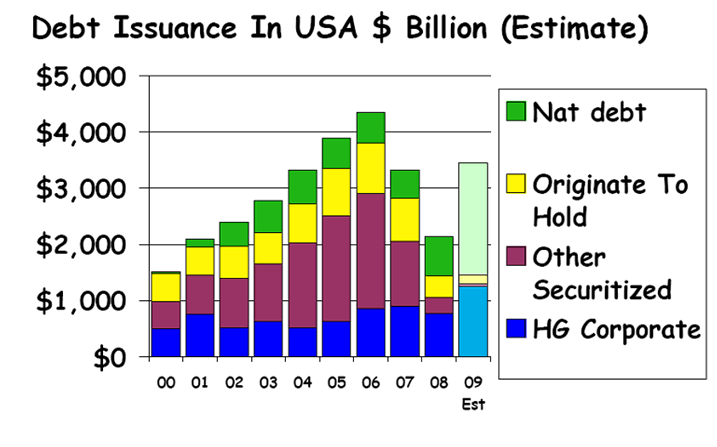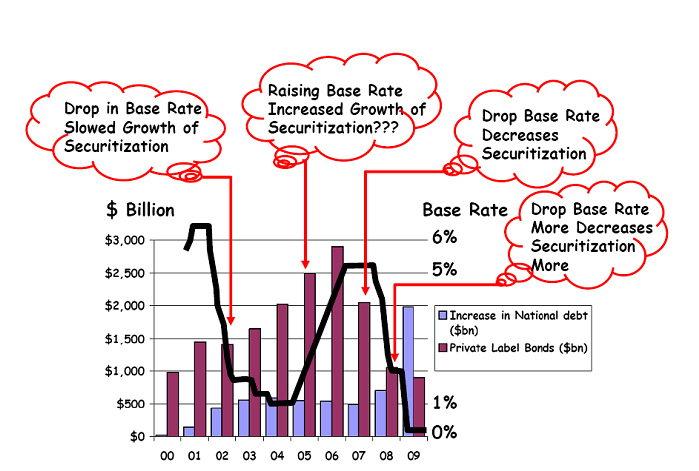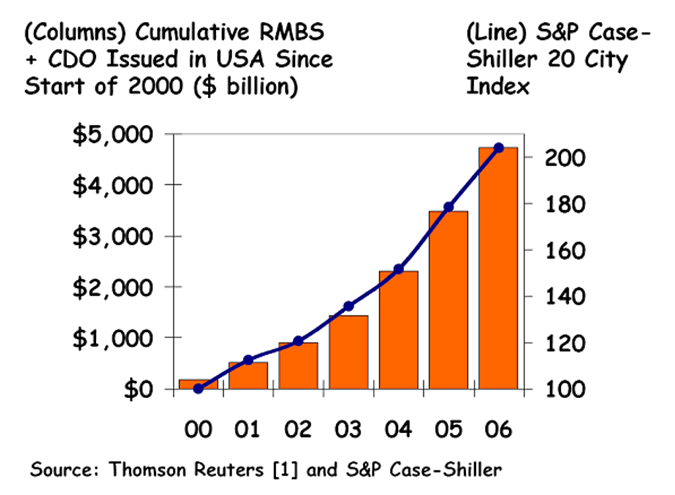The Fed Did NOT Cause the Credit Crunch, It Was Securitization: Here Is Proof!
Interest-Rates / Credit Crunch Jan 06, 2010 - 02:45 AM GMTBy: Andrew_Butter
 In Ben’s big speech the other day he said that it wasn’t the Fed’s fault, and that only 5% of the problem was caused by Greenspan dropping the base rate.
In Ben’s big speech the other day he said that it wasn’t the Fed’s fault, and that only 5% of the problem was caused by Greenspan dropping the base rate.
http://federalreserve.gov/newsevents/speech/bernanke20100103a.htm
Everyone is saying “Oh what a jerk, he’s just covering up, and trying to shift the Fed’s share of the blame”.
Well I can understand the anger, but I’m sorry to break it to you folks, but you are throwing rotten eggs (and tomatoes) at the right people, for the wrong reasons.
Not that I have any objection to that (there are plenty of good reasons to throw rotten tomatoes and rotten eggs at the Fed (and Ben Bernanke); just this isn’t one of them.
It’s a controversial subject, so let me break it down:
1: Everyone agrees (I think) that the cause of the Credit Crunch was Americans borrowing money (to a great extent collateralized by their houses), and then finding out that they could not (or would not) pay the money (plus the interest) back.
2: The main reason they could not (would not) was because the value of the collateral that they had put up to guarantee the loans they had taken out turned out to be a lot less than they (and the people who had lent them money), thought it would be worth when they borrowed the money.
3: So they didn’t pay the money back, so then the people who had lent the money got stuck with the collateral, that didn’t cover the loans they had made, and so they couldn’t pay money back to people they had borrowed it from, and so there was a credit crunch.
4: So the Fed (along with the Treasury) stepped in and lent, gave, and in some cases invested money in the banks to tide them over, a lot of money (and where they got it from is still a subject of intense speculation – but that’s another story).
5. Even so the banks stopped lending and everyone ran out of cash, unemployment went up; that made the problem worse. Plus some morons had written insurance betting that the people who had borrowed the money would pay it back, and then when the “policies” got called they couldn’t pay up, that made the whole thing even worse.
And here we are.
The Legend of the Evil Fed!
The popular legend is that the root cause of all that was because the Fed dropped the base rate in late 2001 and that caused (some say forced) ordinary unsophisticated people to borrow money so they could speculate on the notion of house prices going up. And thanks to the theory of Reflexivity (and common sense) that was a self-fulfilling prophesy, too much money was chasing too few houses so the price of houses went up. Until they went up so much no one could afford one, then the money stopped coming, and then the whole thing went into reverse.
But there is one thing wrong with that theory. It doesn’t fit with the facts (not that such details ever stopped economists promoting their pet theories).
The theory goes that if the Fed drops the base rate then banks make more money lending (bigger spread between short-term money (their cost) and long term money (what they can lend it at), so they lend more, so “credit” becomes more “available” and that’s “Good For America” because everyone spends more. A virtuous circle, until it stops. That’s the old 3-6-3 rule (borrow at 3%, lend at 6% be on the golf course at 3.00 pm).
But securitization changed all that.
With securitization the banks only needed “overnight” cash to lend; they borrowed real short, wrote mortgages and then the sold them on to the securitization industry; or (and this was one really big mistake) held onto them, after they had been subjected to the magic alchemy of securitization.
And the reason that they could do that was because of two things:
(1): The 1984 Secondary Mortgage Market Enhancement Act (SEMMEA) removed restrictions on investment by regulated financial institutions in many private mortgage backed securities.
Until that time regulated Pension Funds and Insurance companies were obligated to hold a proportion of government backed investment grade securities, SEMMEA meant that they could buy the same class of asset with a higher coupon rate. That opened up the floodgates and the private sector was galvanized to meet the new demand; that was the "carrot" that created the securitisation industry in USA.
(2): So once there was the magic AAA stamp banks didn’t have to make a provision against default of all those wonderful MBS, ABS, CDO etc, they could call them like “cash” because as far as the regulators were concerned those thing were as liquid as AAA US Treasuries, and to prove it there was even an “exchange” so they could mark them to market.
That was just the best of all beautiful worlds (of course the market was fixed but that’s also another story).
This is the thing, to do all that it didn’t really matter what the short term interest rate was, thanks to the securitization process they could borrow very short, take that money and lend it to the home-buyers, thank you very much, then they took the mortgages, securitized them and the people who did that sold them to the “suckers” then they took the money, paid back the short-term loan; and then did it one more time…Baby!
No one cared what short-term money cost.
This is a slide showing how the pile of debt that America as a whole racked up over the past ten years ended up.

See the yellow bars, that’s the “traditional – Originate-to-Hold” stuff, that’s what’s affected by dropping the base rate, drop the rate, that goes up (a bit) increase the rate, it goes down (a bit).
That’s the bit Allan Greenspan was keeping his wary eye on.
Notice also, it’s a pretty small part of the pie; Alan Greenspan’s mistake was that he needed a new set of glasses.
Don’t believe me? Well have a look at this chart:

That’s a chart comparing the issuance of private-label bonds compared to the Fed base rate (that’s the black line (scale on the right)).
Everyone agrees that what really caused the credit crunch was all those AAA and other bits of securitized debt, turned out to be worth a lot less than the people who bought them or held them on their books, thought they would be worth (today), when they bought them or manufactured them (a few years ago).
So explain this then, if the Fed was “responsible” for all that toxic crap that is currently clogging up the gullet of every bank in USA (and elsewhere – a lot was sold to suckers overseas), then if the Fed was “Bad” the action of lowering the interest rate should have meant that more of that stuff was produced.
Well look at the chart – in fact it’s the opposite.
(1): At the end of 2001 the base rate was dropped like a stone (mainly if I recollect in response to Osama bin Laden – so it’s his fault! He says it was all part of his plan).
But look what happened – 2000 to 2001 securitization increased 50% (it had increased 50% the year before too (not shown)), and what happened in 2002 – growth stalled. The reason presumably was that more “traditional” Originate-to-hold was issued (if you squint at the preceding chart you can see that happened).
(2): OK after a pause – the inevitable growth started again, but look, the growth was pretty steady and as the base rate was increased, IT GREW MORE.
Conclusion- the housing bubble and all the rest were CAUSED by RAISING rates, in 2005!! Err…put that in your “inflation targeting” pipe and smoke it.
(3): Then they started to drop the base rate, and Securitisation stalled, growth went down, so dropping the base rate REDUCED the production of the toxic crap that is poisoning America.
That proves (as far as I am concerned) that Allan Greenspan’s much admired tinkering with the base rate did nothing at all – he thought he was the Great Captain of the economy, he wasn’t he was irrelevant.
Still don’t believe me?
How about this chart:

That’s “toxic crap” cumulative compared to house prices, OK only seven pairs of data but the correlation is 98% and the Student’s “T” Statistic is 6.4.
By contrast the best Ben could produce in his “The Fed didn’t do it” address; was an R-Squared 31% and a 2.3 “t” statistic.
That’s a better chart.
Where the Fed went wrong:
The “job” of the Fed (I paraphrase) is to ensure financial stability, control inflation (not of assets of course – ha ha), be the lender of last resort, and make sure that there is full employment.
It is clear that they didn’t do their job.
They say it’s because of this or that; but none of what they say is very convincing, and given that the current problem was caused by bubbles (Dot.com followed by housing) and (a) both Allan Greenspan and Ben Bernanke are proud that they can’t spot one, and (b) Allan Greenspan was adamant that even if could have spotted one, he would have done nothing about is, it’s not hard to figure out the main cause of the problem.
Basically they need better spectacles.
George Soros said, correctly, that (a) if someone who gave a damn had persuaded the SEC (even if it wasn’t under the Fed’s jurisdiction it was under their remit), to cut back or freeze IPO’s in the build up to the Dot.com; there would not have been that bubble, (b) if in 2003 or 2004 the Fed had persuaded someone (again not their jurisdiction but their remit), that no mortgages could be written with an LTV more than 60%, until further notice, there would not have been a housing bubble (they do that in Hong Kong).
And if Greenspan, Summers and Rubin hadn’t shut Brooksley Born down, derivatives would have been regulated just like corn futures, so the collateral damage of the pop would have been much less.
Those were their mistakes – that’s what people should be angry about and throwing rotten tomatoes at them for. And those are the things that need to be fixed first, because those were the things that broke.
Lowering the base rate was irrelevant.
So ought to be discussions about “fire-fighting” the next time they screw up so bad; granted fire-fighters are important, but the best way to make sure there are no fires is to stop people starting them.
By Andrew Butter
Twenty years doing market analysis and valuations for investors in the Middle East, USA, and Europe; currently writing a book about BubbleOmics. Andrew Butter is managing partner of ABMC, an investment advisory firm, based in Dubai ( hbutter@eim.ae ), that he setup in 1999, and is has been involved advising on large scale real estate investments, mainly in Dubai.
© 2010 Copyright Andrew Butter- All Rights Reserved
Disclaimer: The above is a matter of opinion provided for general information purposes only and is not intended as investment advice. Information and analysis above are derived from sources and utilising methods believed to be reliable, but we cannot accept responsibility for any losses you may incur as a result of this analysis. Individuals should consult with their personal financial advisors.
Andrew Butter Archive |
© 2005-2022 http://www.MarketOracle.co.uk - The Market Oracle is a FREE Daily Financial Markets Analysis & Forecasting online publication.



